Cancer Genetics
1/52
There's no tags or description
Looks like no tags are added yet.
Name | Mastery | Learn | Test | Matching | Spaced |
|---|
No study sessions yet.
53 Terms
Cancer is what type of disease?
genetic
Cancer is a genetic disease that develops how?
in predictable sequence of steps
Carcinogenesis
transformation of a normal cell into a cancerous cell
Carcinogenesis can also be known as?
tumorigenesis
Mutations in three classes of genes contribute to what?
oncogenesis/tumorigenesis
Oncogenesis
- mutations are gain of function (Ras/Raf)
- provide a persistent proliferative signal
Oncogenes are dominant or recessive?
dominant
What does dominant Oncogenes mean?
only one allele has to be affected to cause an abnormality
Most oncogenic activations occur through mutations in genes involved in what?
growth factor signaling
What do these growth factor signaling include in the mechanisms of tumorigenesis by oncogenes?
1. growth factors
2. receptors for growth factors
3. intracellular signaling pathway components
4. transcription factors
- other types of oncogenes: telomerase, anti-apoptotic proteins
When we receive a stimulus from the outside, what part of the growth factor signaling (mechanism of tumorigenesis by oncogenes) is triggered the most?
1. growth factors
2. receptors for growth factors
3. intracellular signaling pathway components
What are the 4 different types of mutations that can turn a Proto-Oncogene into a Oncogene?
1. Mutation in coding sequence
2. Gene amplification
3/4. Chromosome rearrangement
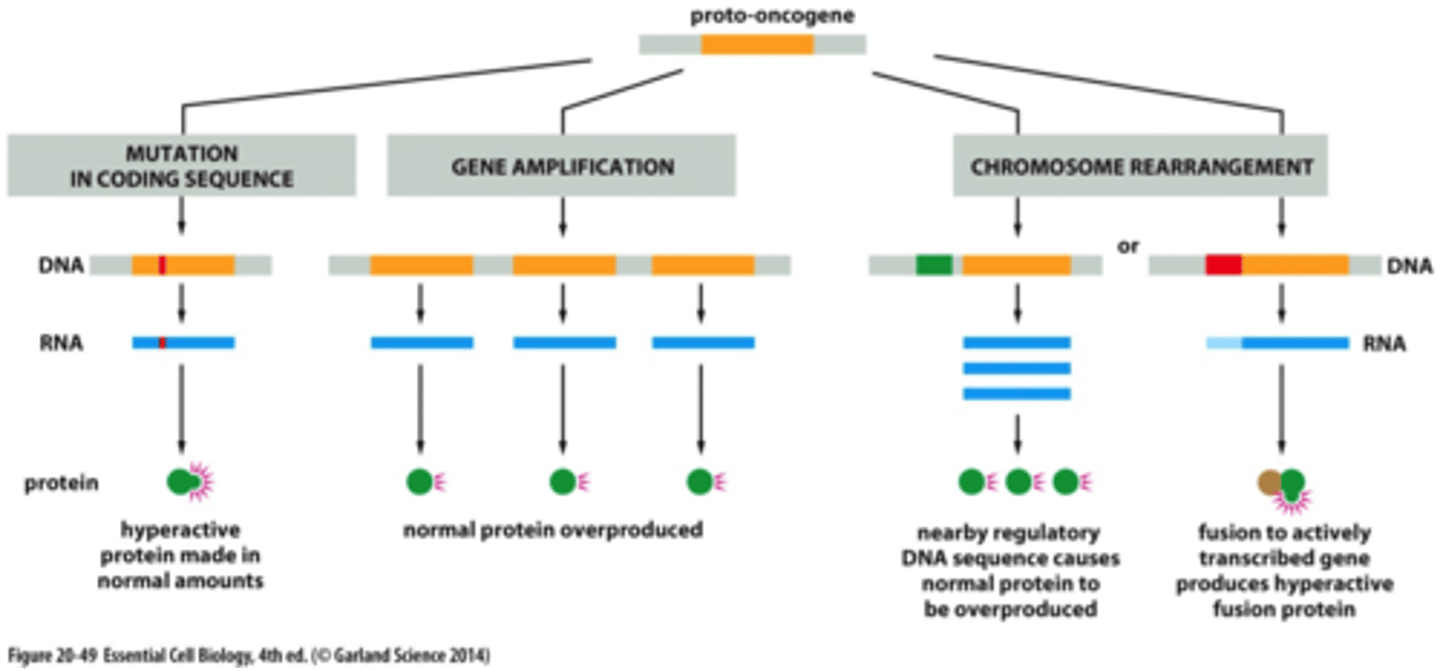
Mutation in Coding Sequence (Proto-Oncogene to Oncogene)
hyperactivity protein made in normal amounts
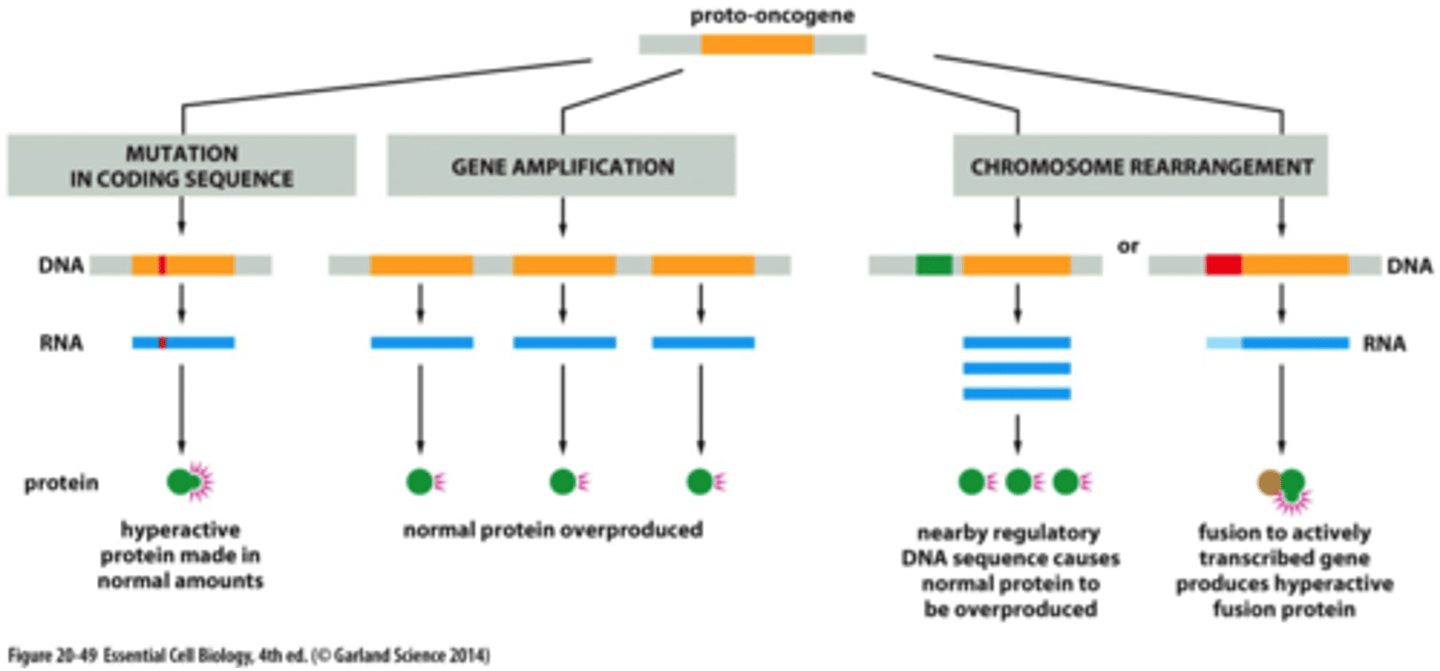
What is an example of Mutation in Coding Sequence that leads to hyperactivity of the protein?
HER2/Neu or ERBB2 which leads to sporadic breast cancer from a mutation in the gene
Gene Amplification (Proto-Oncogene to Oncogene)
normal protein greatly overproduced
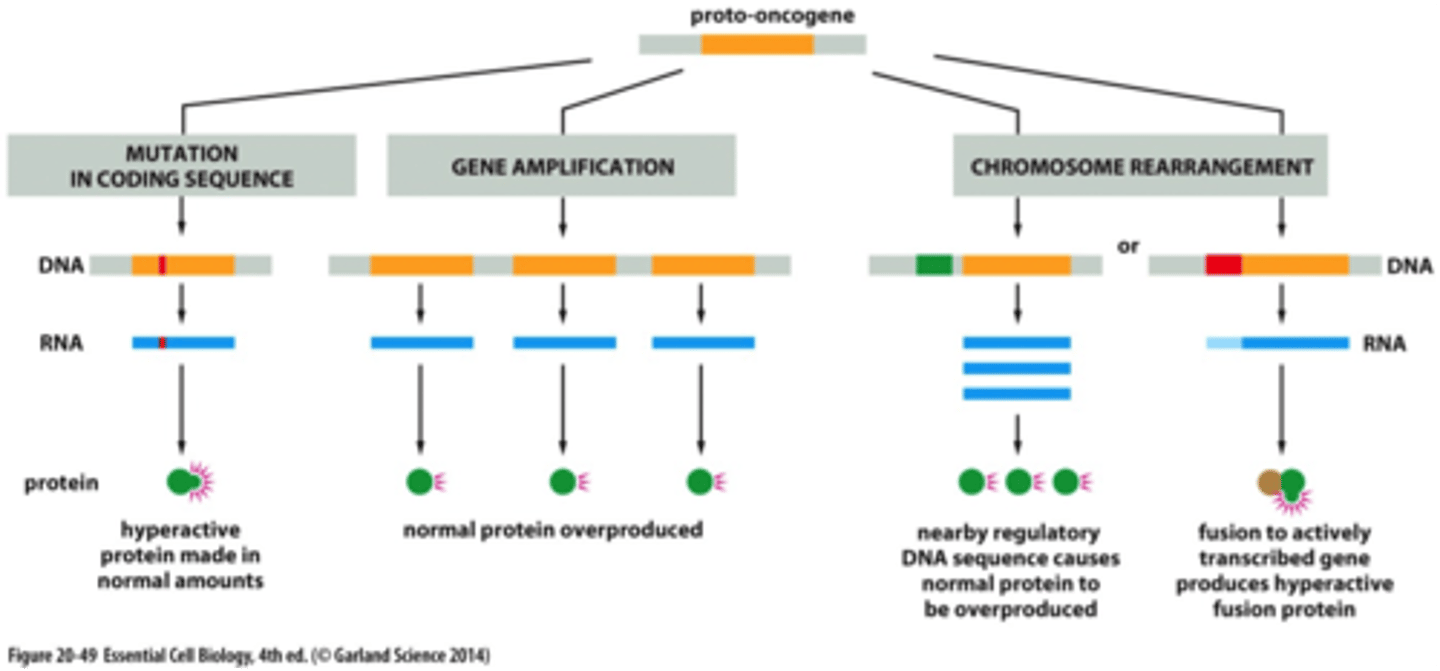
What is an example of Gene Amplification that leads to overproduction of the normal protein?
Myc (C-myc, N-myc, L-myc), which is a transcription factor
C-myc
rapidly proliferating cells
N-myc
expressed in pre-B cells, kidney, brain, and intestine
L-myc
expressed during embryogenesis in the kidney and lung
Chromosome rearrangement (Proto-Oncogene to Oncogene)
will rearrange the chromosomes in a way that it is not supposed to be
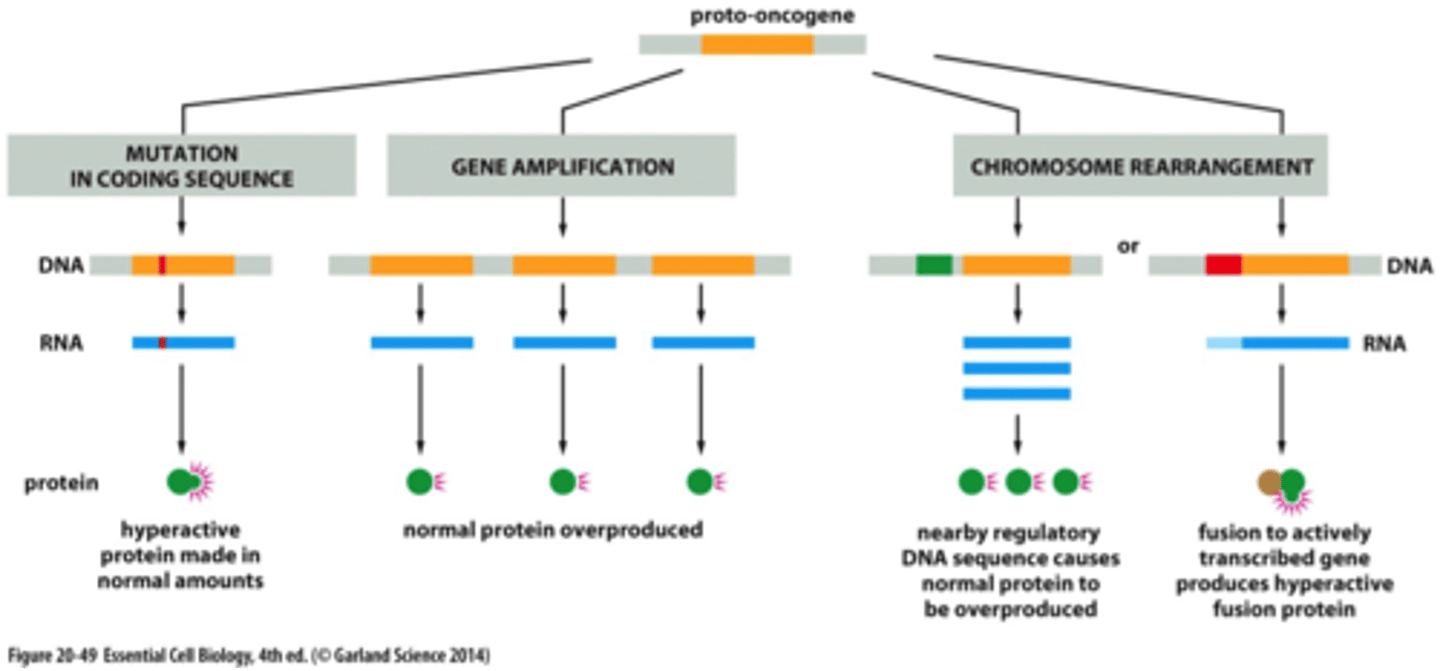
What are the two different types of chromosome rearrangements (Proto-Oncogene to Oncogene)?
1. nearby regulatory DNA sequence causes normal production to be overproduced
2. fusion to actively transcribed gene produces hyperactive fusion protein
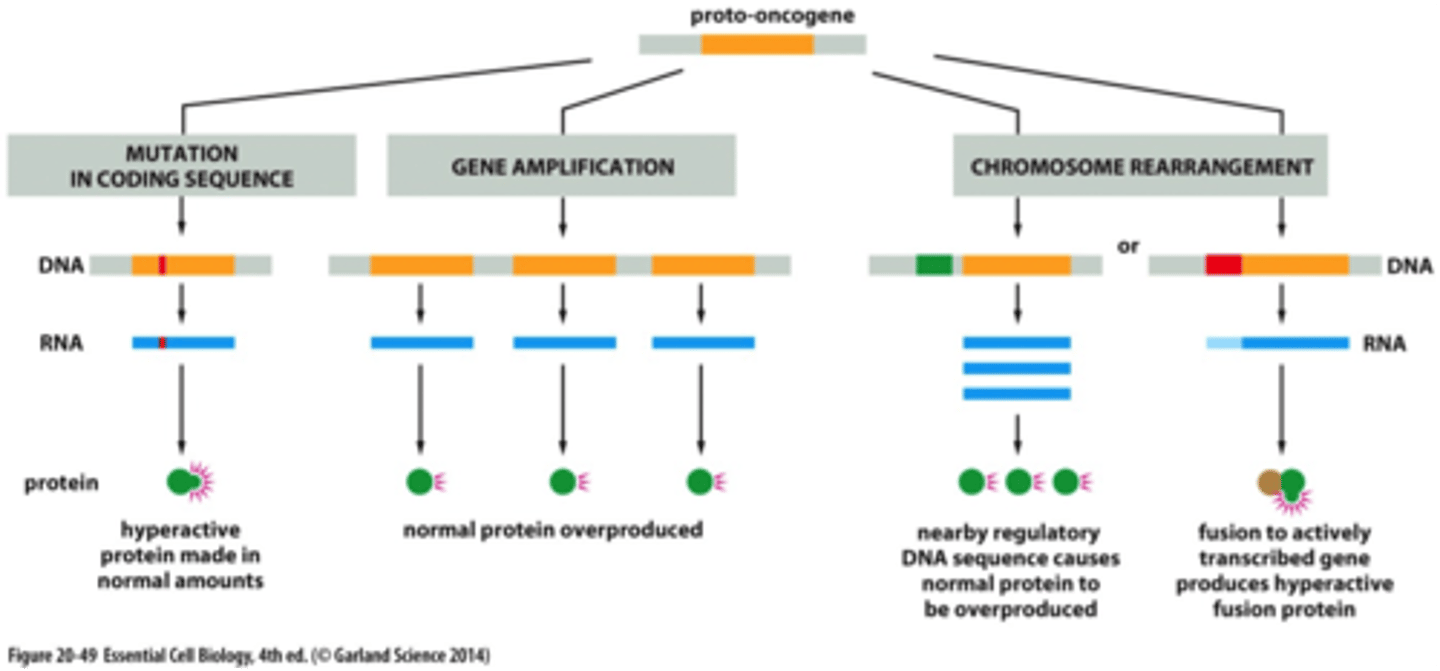
Chromosome Rearrangement #1 - nearby regulatory DNA sequence causes normal production to be overproduced
multiple copies of SAME genes produced
What is an example of Chromosome Rearrangement that leads to multiple copies of the same gene produced?
Burkitt's lymphoma - exchanging of Myc and IgH on the chromosomes
Chromosome Rearrangement #2 - fusion to actively transcribed gene produces hyperactive fusion protein
not always expressed but when expressed it is overactive
What is an example of Chromosome Rearrangement that leads to overactive expression with fusion protein?
BCR-ABL - fusion of two genes (BCR and ABL) into one chromosome
Tumor suppressor genes
- mutations are a loss of function (Rb, p53, p21)
- gatekeeper tumor suppressors = control cell growth
- caretaker tumor suppressors = protect the integrity of the genome
Are Tumor Suppressors dominant or recessive?
recessive
What does Recessive Tumor Suppressor mean?
both alleles have to be affected to cause an abnormality
What model does the recessive tumor suppressor have?
two-hit
What is this "two-hit" model?
1. mutation event inactivates one allele of a tumor suppressor, but the unaffected allele can still function
2. a second mutation event MUST occur that inactivates the unaffected allele, resulting in the complete functional elimination of the tumor suppressor gene
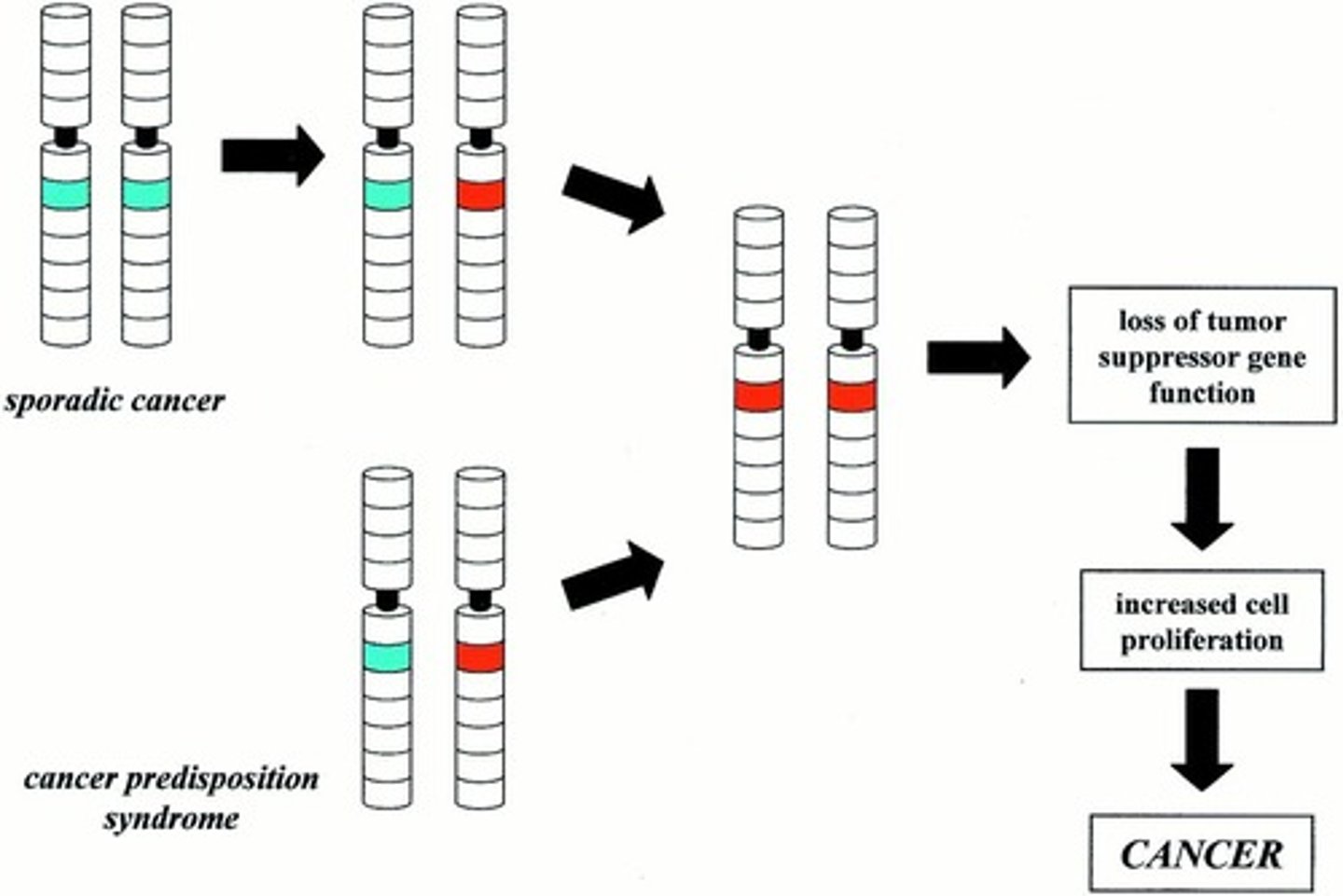
Oncomirs (Oncogene microRNAs)
play a role in regulation of gene expression
Loss of miRNA's means what?
that function as tumor suppressor can allow overexpression of onocogenes
*MEANING = if you lose something by nature that inhibits oncogenes - it will lead to MORE cancer
Over expression of miRNA's means what?
that inhibit tumor suppressors can promote tumor progression
*MEANING = not stopping the tumor suppressor will lead to cancer development
Sporadic Cancer
cancer due to accumulation of genetic mutations over time in an individual
What is Sporadic Cancer NOT due to?
inherited mutation
What is the % of cancer cases that are sporadic?
80
Familial Cancer
cancers that occur in families more often than what could be expected by chance
What is Familial Cancer typically from?
combination of risk factors and environmental factors
*MEANING = not in genetic makeup however it happens or occurs because of their environment (same triggers, stressors, diet, ect.)
Inherited Cancer
cancer that results from genetic mutations that are passed on from one generation to the next
What is the % of cancer cases that are due to inheritance?
5-10
What are the features that suggest Hereditary (genetic meaning) Cancer?
- usually early age of cancer onset (premenopausal breast cancer)
- cancers offering in multiple generations of a family (autosomal dominant inheritance - breast cancer)
- unusual presentation of cancer (male breast cancer)
- rare cancers associated with birth defects (Wilms tumor and genitourinary abnormalities - children)
Genes that are involved with hereditary cancers are generally oncogenes or tumor suppressors?
tumor suppressors
What are mutliple examples of genes that are involved in hereditary cancers that involve tumor suppressors?
- Li-Fraumeni Syndrome = TP53
- Von Hippel-Lindau Syndrome = VHL
- Hereditary Breast-Overian Cancer Syndrome = BRCA 1 and 2
- Hereditary Nonpolyposis Colon Cancer (Lynch Syndrome) = MLH1/ MSH2
- Familial Adenomatous Polysis = APC
- Neurofibromatosis = NF1
- Multiple Endocrine Neoplasia type 1/2 = MEN (Type 1) and RET (type 2)
- Retinoblastoma = RB1
What are the tumor suppressor/Oncogene expressed in Multiple Endocrine Neoplasia?
- (TYPE 1) MEN1 = tumor suppressor that regulates transcription of genes involved with cell proliferation
- (TYPE 2) RET = receptor tyrosine kinase ONCOGENE that leads to persistent proliferative signal
What are the tumor suppressor expressed in Li-Fraumeni Syndrome?
mutation in TP53
- extremely rare inherited cancer syndrome that is associated with a variety of cancers including breast, brain, leukemia, sarcomas, and adrenal carcinomas
Li-Fraumeni Syndrome is considered autosomal dominant or recessive; would would this mean?
dominant, meaning inheriting an abnormal copy of a particular gene from ONE parent is sufficient enough for the disease to be present
What are the tumor suppressor expressed in Retinoblastoma?
mutations in RB1
- ~99% of cancer if mutation is inherited
What are the tumor suppressor expressed in Von Hippel-Lindau Syndrome?
mutations in VHL
- this mutation will inhibit formation of blood vessels which give rise to highly vascularized tumors
What are the tumor suppressor expressed in Hereditary Breast-Overian Cancer Syndrome?
mutations in BRCA1/BRCA2
- 85% risk of cancer if mutation is inherited
What are the tumor suppressor expressed in Hereditary Nonpolyposis COLON CANCER - Lynch Syndrome?
mutations in MLH1 or MSH2
- inactivation leads to increase in point mutations (RER+) phenotype = causes frameshift and carry out a mutation in a different sequence
What is an example used of Hereditary Nonpolyposis COLON CANCER - Lynch Syndrome, that is used to IDENTIFY RER+ phenotype?
Micro-satellite Polymorphic markers
- mutations will result in either an increase/decrease in size of specific micro-satellite regions in the DNA
What are the tumor suppressor expressed in Familial Adenoamtous Polyposis (FAP)?
mutations in APC
- colorectal cancer
- 100% risk of cancer if mutation is inherited
What are the tumor suppressor expressed in Neurofibromatosis?
mutations in NF1 (negative regulator of Ras signaling pathway)
- individuals develop tumors of the nervous system these are usually BENIGN